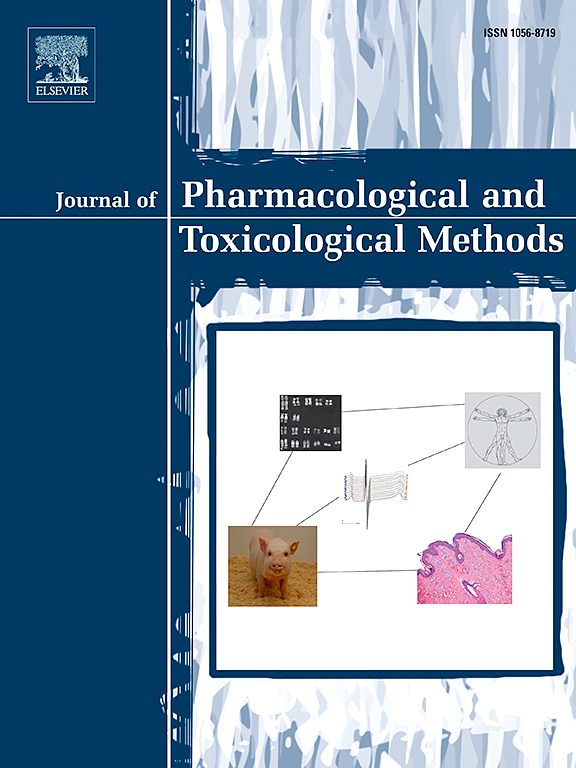结合系统免疫学方法和体外数据评估甲型流感病毒感染后药物诱导的免疫反应变化——生物制剂感染风险临床前评估的蓝图
IF 1.3
4区 医学
Q4 PHARMACOLOGY & PHARMACY
Journal of pharmacological and toxicological methods
Pub Date : 2025-05-01
DOI:10.1016/j.vascn.2025.107682
引用次数: 0
摘要
生物模式,如基于抗体的生物制剂,在过去几年中已经彻底改变了许多肿瘤和炎症性疾病的治疗。尽管与合成免疫抑制分子相比,感染被认为对脱靶相互作用的混杂性更小,但感染仍然是一个关键的安全性考虑因素。靶向免疫系统成分的免疫抑制调节使感染性有机体有更大的机会传播或重新激活并在治疗患者中引起疾病。了解受调节的免疫系统如何对抗感染对于评估和预测治疗性生物制剂的潜在并发症至关重要。对感染的免疫反应是一个复杂的生物学过程,涉及多种细胞类型、途径和解剖区室,很难仅在体外分析水平上解释。数学模型和计算机模拟已被广泛用于研究对感染的免疫反应,例如甲型流感病毒(IAV)。我们使用了一个数学模型[Lee et al. (2009), Journal of Virology],该模型代表了已发表的关于IAV感染的实验结果,以研究临床前分子对IAV特异性免疫反应的影响,并将其与具有重叠作用机制的临床或上市竞争对手药物进行比较。这些药物旨在通过抑制共刺激T细胞受体,导致效应CD4+和CD8+ T细胞的增殖减少,从而抑制自身免疫性疾病中的自身反应性T细胞。对于每种药物,使用混合淋巴细胞反应测定的体外数据来量化对T细胞增殖的浓度依赖性抑制,并将其整合到模型中。模拟两种情况下对IAV感染的药物特异性免疫反应,即在治疗期间发生的原发性IAV感染和在治疗期间发生的继发性IAV感染,而IAV记忆已经建立。生成并比较了免疫反应改变的两种硅生物标志物,即病毒清除时间和抗体水平的浓度依赖性变化,可达30 天。因此,对IAV感染的免疫反应的药物依赖性调节在原发性和继发性感染中是一致的。此外,临床前候选药物对免疫反应的调节可以排在两种已经上市的药物之间。这使我们能够排除与具有既定临床安全性的竞争对手相比,与临床前候选药物相关的明显风险负担。这种计算机研究是通用的,因为系统免疫学模型既不适合特定的模式,也不适合新的生物或化学实体的精确作用模式。相反,药物对免疫系统的特异性作用是通过体外数据整合到模型物种的机制描述中来表示的。此外,该研究还可作为定量评估各种常见感染及其相关风险(包括结核病重新激活)的蓝图。本文章由计算机程序翻译,如有差异,请以英文原文为准。
Combining a systems immunology approach with in vitro data to evaluate drug-induced changes in the immune response after Influenza A Virus infection – A blueprint for the preclinical assessment of infection risks for biologics
Biological modalities, such as antibody-based biologics, have revolutionized the treatment of many neoplastic and inflammatory diseases over the last years. Although being considered as less promiscuous to off-target interactions than synthetic immunosuppressive molecules, infections remain a key safety consideration. The immunosuppressive modulation of targeted immune system components allows infectious organisms a greater chance to spread or reactivate and cause disease in treated patients. Understanding how the modulated immune system combats infection is crucial to assess and predict potential complications of therapeutic biologics. The immune response to infections is a complex biological process, involving multiple cell types, pathways, and anatomical compartments, and is difficult to interpret solely at the level of in vitro assays. Mathematical models and computer simulations have been widely used to study immune responses to infections, e.g., in case of Influenza A Virus (IAV). We used a mathematical model [Lee et al. (2009), Journal of Virology] which represented published experimental findings on IAV infection to study the effect of a preclinical molecule on an IAV-specific immune response as compared to clinical or marketed competitor drugs with overlapping mechanism of action. The drugs are intended to inhibit autoreactive T cells in autoimmune diseases via inhibition of co-stimulatory T cell receptors leading to a decreased proliferation of effector CD4+ and CD8+ T cells. For each drug, in vitro data derived from mixed lymphocyte reaction assays were used to quantify the concentration-dependent inhibition of T cell proliferation and were integrated into the model. The drug-specific immune responses to IAV infection were simulated for two scenarios, i.e., primary IAV infection occurring during the treatment, and secondary IAV infection occurring during the treatment while IAV memory had already been established. Two in silico biomarkers of the altered immune responses were generated and compared, i.e., concentration-dependent changes in the time to viral clearance and in the antibody levels up to 30 days. As a result, the drug-dependent modulation of immune responses to IAV infection were consistent for primary and secondary infection. Furthermore, modulation of the immune response by the preclinical candidate could be ranked between those of two already marketed drugs. This allowed us to exclude the burden of an overt risk associated with the preclinical candidate as compared to the competitors which have an established clinical safety profile. This in silico study is generic since the systems immunology model is neither tailored to a specific modality, nor to the precise mode of action of the new biological or chemical entity. Instead, drug-specific actions on the immune system are represented by in vitro data integrated into the mechanistic description of model species. Furthermore, the study serves as a blueprint for the quantitative assessment of various common infections and their associated risks, including reactivation of Tuberculosis.
求助全文
通过发布文献求助,成功后即可免费获取论文全文。
去求助
来源期刊

Journal of pharmacological and toxicological methods
PHARMACOLOGY & PHARMACY-TOXICOLOGY
CiteScore
3.60
自引率
10.50%
发文量
56
审稿时长
26 days
期刊介绍:
Journal of Pharmacological and Toxicological Methods publishes original articles on current methods of investigation used in pharmacology and toxicology. Pharmacology and toxicology are defined in the broadest sense, referring to actions of drugs and chemicals on all living systems. With its international editorial board and noted contributors, Journal of Pharmacological and Toxicological Methods is the leading journal devoted exclusively to experimental procedures used by pharmacologists and toxicologists.
 求助内容:
求助内容: 应助结果提醒方式:
应助结果提醒方式:


